Pad woon sen is a delicious and easy to make Thai glass noodle stir fry, packed with colorful veggies and tossed in a sweet and savory sauce. It’s a comforting meal that may just become a family favorite! Ready in less than 25 minutes from start to finish.
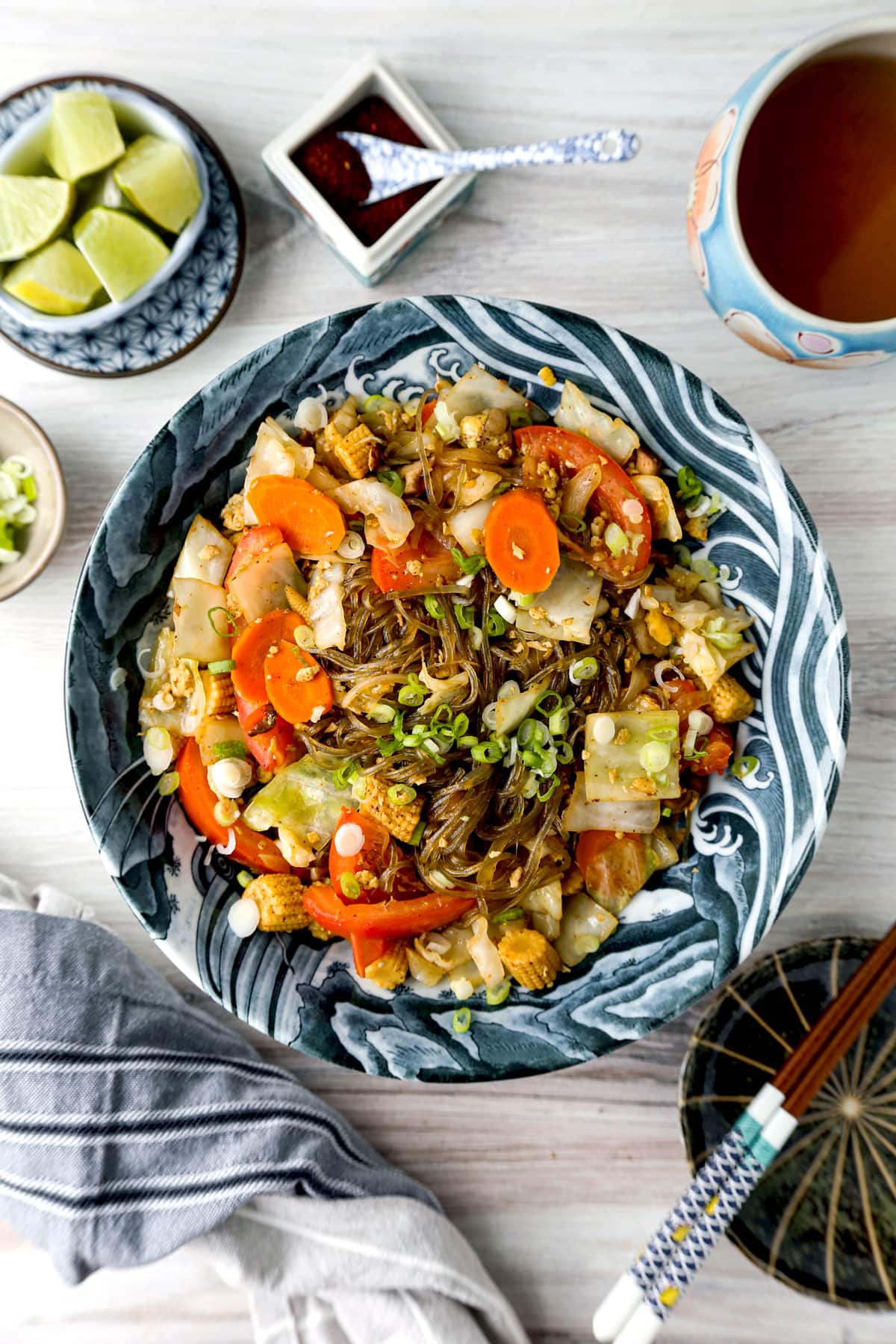
Table of contents
What is Pad Woon Sen?
Pad woon sen (ผัดวุ้นเส้น) is a Thai noodle stir fry made of glass noodles, vegetables, protein and eggs. The flavor profile is both savory and mildly sweet – and has a great juxtaposition of both crunchy and chewy textures.
While pad woon sen isn’t as well known in the West as take-out favorites like pad Thai or pad see ew, it is ubiquitous in Thailand and has many variations.
For this particular Thai noodle recipe, I’m jettisoning the chicken or pork you’d normally find in pad woon sen in favor of crunchy veggies and scrambled eggs. Trust me, there’s so much flavor in this Thai classic, you won’t miss the meat!
So gather up your ingredients and fire up the stovetop. Let’s make pad woon sen at home!
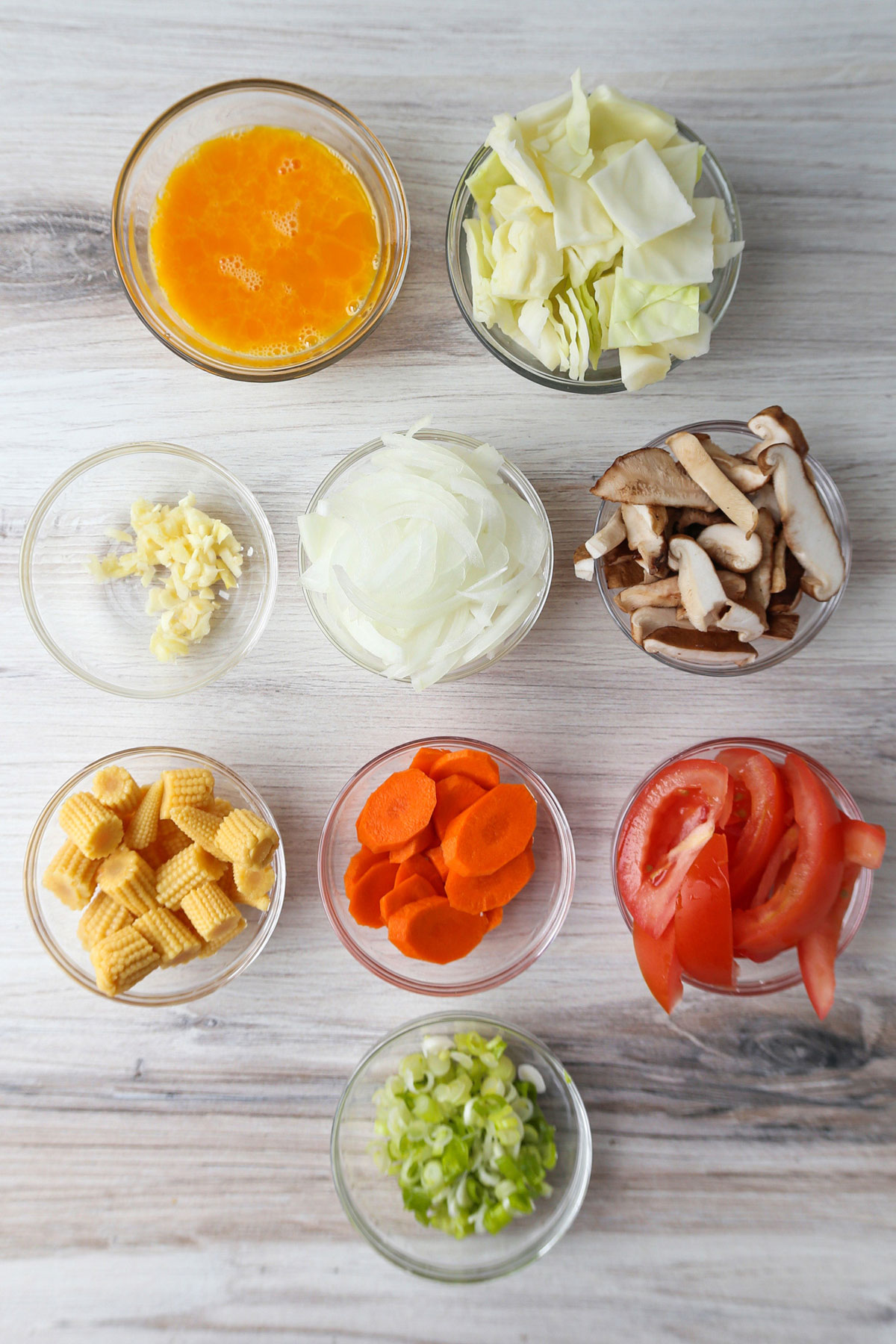
Ingredients for Pad Woon Sen
Scroll all the way down for the full recipe.
- Glass Noodles: These slippery noodles are made from mung beans (more on that in a second) and make the perfect base for this Thai noodle dish.
- Woon Sen Sauce: I’m using a combination of soy sauce, oyster sauce and fish sauce for a mixture that is equal parts savory, sweet, saline and umami. And I mix in a bit of sugar and chili powder. The chili powder in particular lends an aromatic, smoky, almost charred element to the mix. This combination makes a great all-purpose stir fry sauce as well.
- Vegetable Oil: Actually any neutral flavored oil will work for this noodle stir fry. Something like olive oil would be too strong though.
- Eggs: 2 large whisked pasture raised eggs deliver a nice bit of protein to this otherwise vegetarian Thai noodle recipe. Look for certified humane or animal welfare approved on the carton.
- Veggies: I’m using julienned onion and minced garlic for a solid base of flavor. And I think chopped cabbage with sliced carrots and shiitake mushrooms really works for this veggie forward noodle dish. Baby corn provides yet another pleasing layer of crunchiness to the mix here… definitely recommended!
- Tomatoes: Tomatoes are just the best in Thai noodles (I love them in this pad kee mao recipe too). Cut them into wedges – and be sure to remove the seeds so your pad woon sen doesn’t turn out too watery.
- Scallions: Chopped green onions are a favorite last minute garnish just before serving. For more garnishes, have a look at a couple of my favorites further down the page.
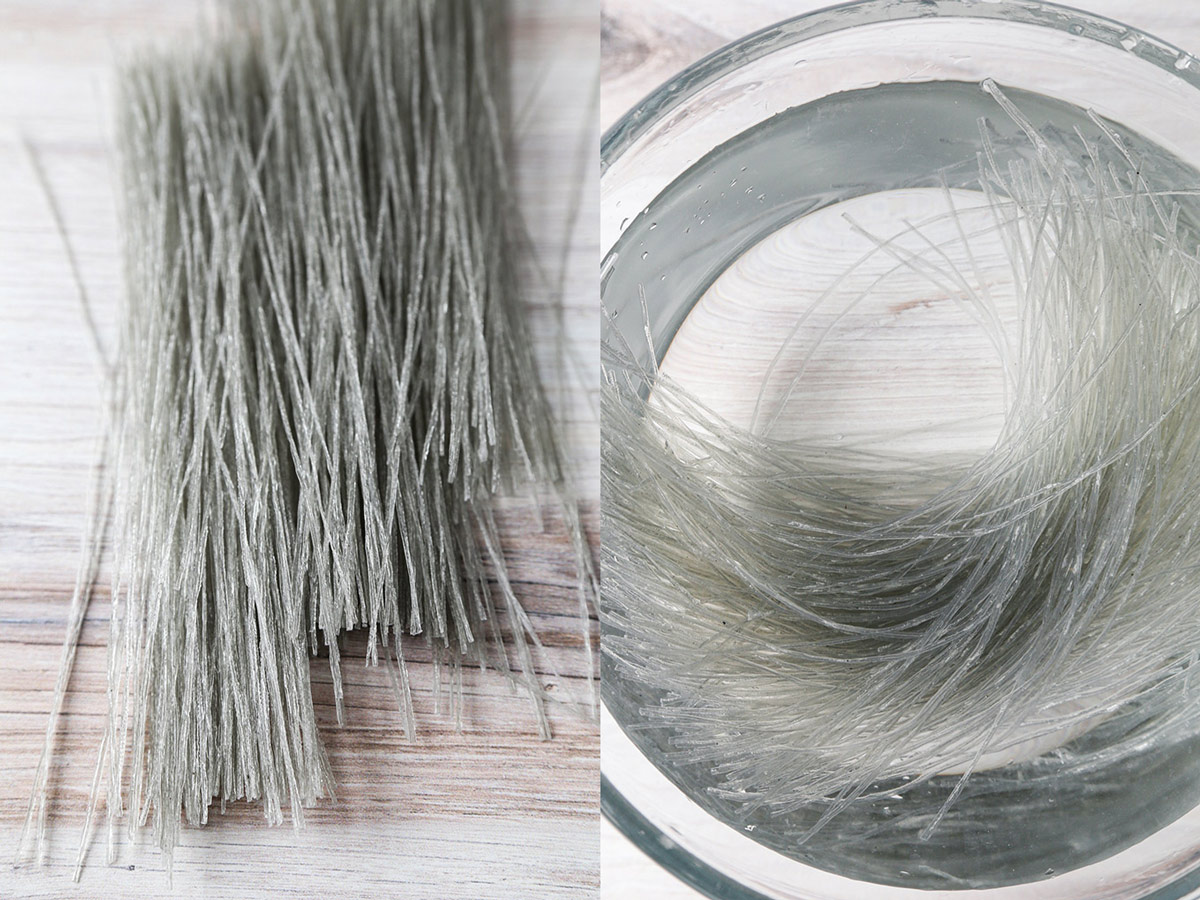
What are Glass Noodles?
Glass noodles are thin noodles that run the gamut from looking almost clear to slightly opaque and white. These gluten free noodles are sometimes called cellophane noodles, glass noodles and bean thread noodles (that last one because they are frequently made from mung beans).
However, some Korean glass noodles are made from sweet potatoes – like the noodles used in this Japchae recipe. So it can all seem a little confusing.
Add to that confusion that glass noodles are different from rice vermicelli. Rice vermicelli has a solid white appearance (and is made from rice) – while bean thread noodles are typically referred to as clear noodles because of their grayish, transparent and glassy appearance.
Just keep it simple. When you head into the Asian grocery store, ask for cellophane, glass or bean thread noodles – or pick them up easily on Amazon here.
How to Cook Glass Noodles
No matter what you call them though, glass noodles are very simple to prepare!
They can usually be hydrated and ready for use with a soak in warm or tepid water. Although some brands will require a quick boil. So be sure to follow the directions on the package for the best outcome.
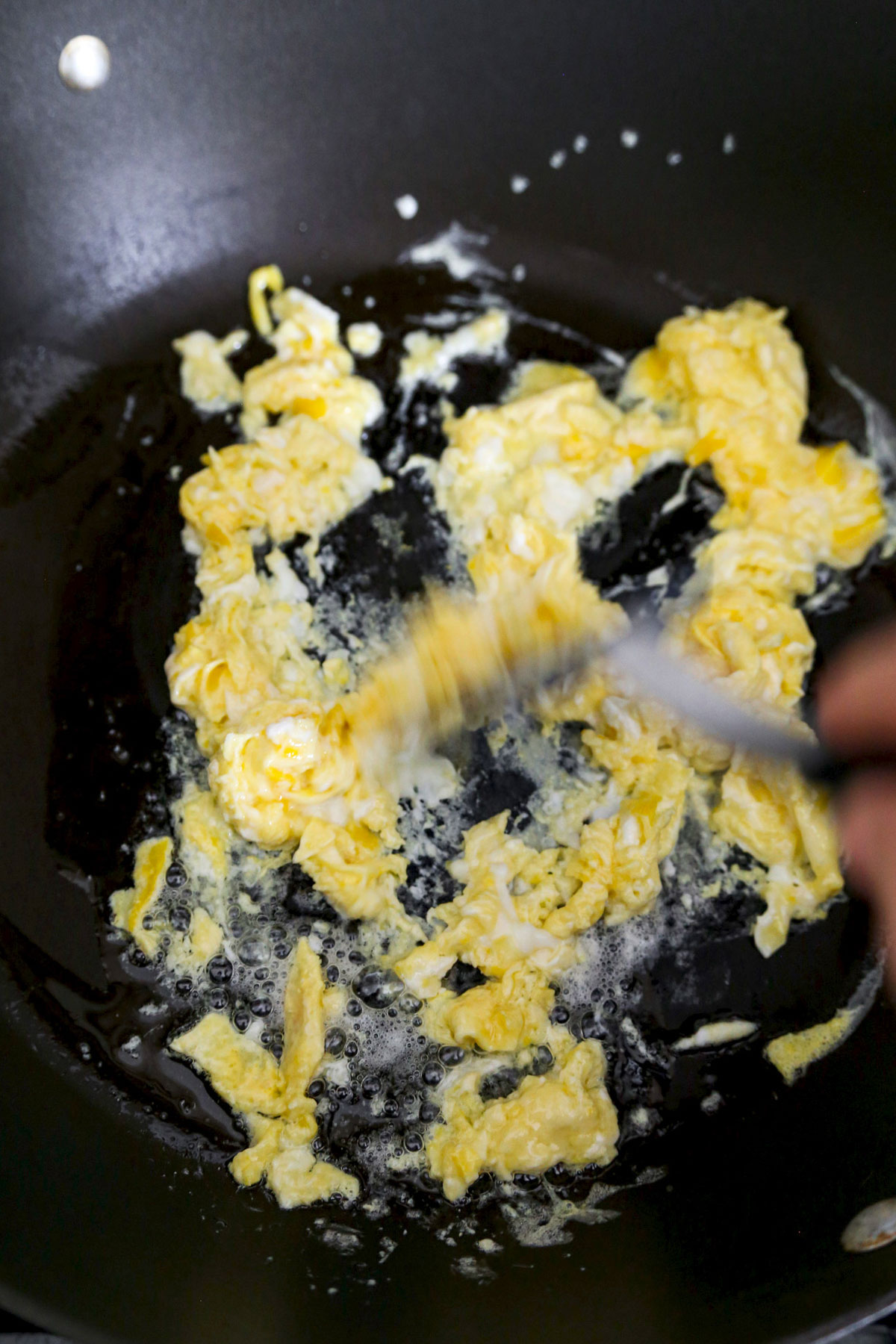
How to Make Pad Woon Sen
- Gather all your cooking tools and ingredients.
- Prepare the glass noodles. Most packaged bean thread noodles will be ready after a 15 minute soak in tepid or warm water. (Be sure to read those package instructions though.) Drain your prepared noodles well and set them aside.
- Make your stir fry sauce. Mix your soy sauce, oyster sauce, fish sauce, sugar, water and chili powder in a small bowl and set aside.
- Scramble the eggs. Add your vegetable oil to a wok or deep skillet over medium high heat. Once your pan is hot add your whisked eggs and scramble them lightly.
- Add the vegetables. Get the onion, carrot, garlic, cabbage and baby corn into the wok and stir fry for about 3-4 minutes. The ideal texture is that the veggies soften slightly but still yield a nice crunch.
- Add the glass noodles and woon sen sauce. Stir fry well and keep going until the noodles have absorbed most of the sauce.
- Transfer the noodles to a plate and top with scallions. Serve immediately. (However pad woon sen is delicious at room temperature too!)
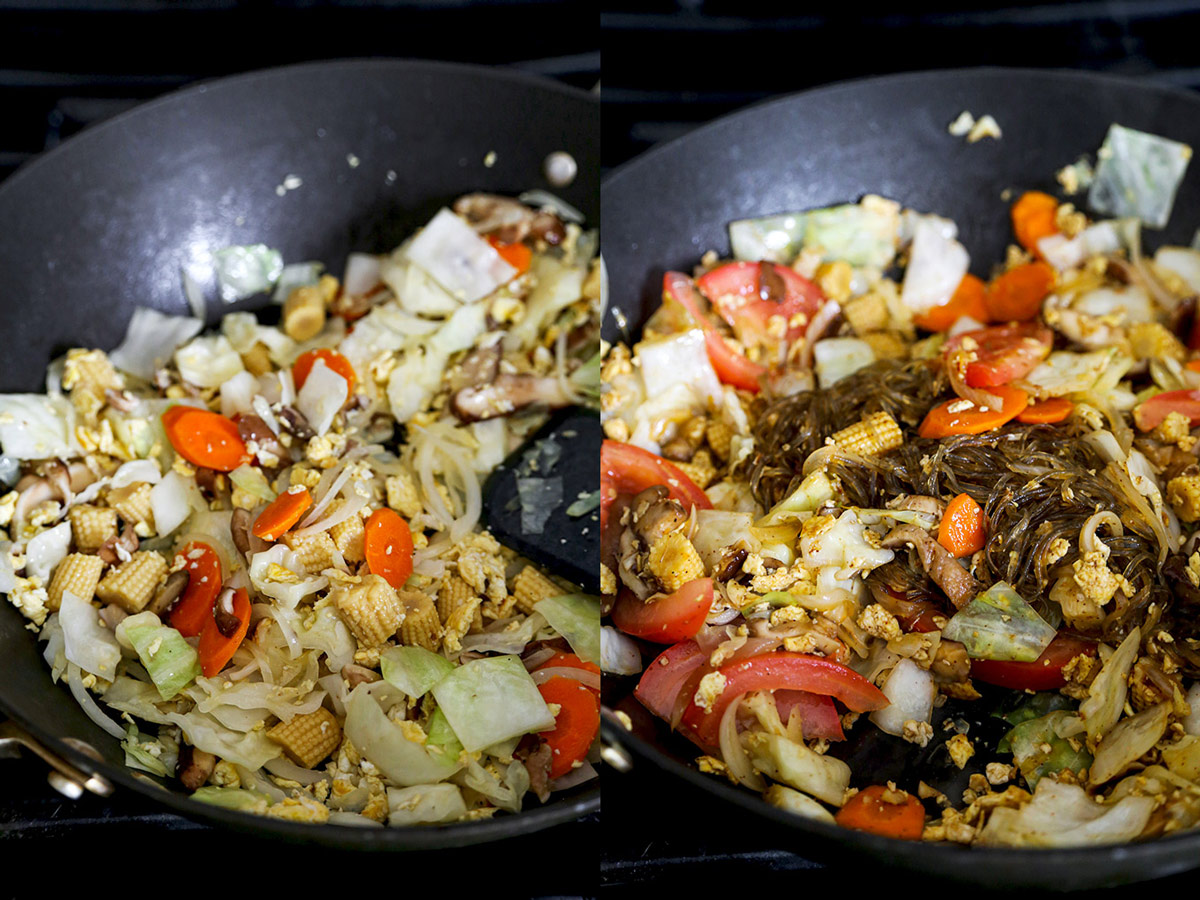
Optional Garnishes
While you can just plate these Thai noodles up and serve them as-is, you may want to lay out a few optional garnishes so people can personalize their own plates. I already mentioned including chopped scallions above.
But here are a few other options:
- Sliced Lime: I love a lime wedge or two. A spritz just before serving elevates the sour quotient and plays so nicely with a little added fish sauce.
- Fish Sauce: This is the table salt of Southeast Asia. While a little nam pla goes a long way, this whiskey colored condiment made of fermented anchovies makes this Thai recipe sing. And you can always add sliced chilis to your fish sauce if you need a little fire in your life.
- Sliced Bird Chilis: Don’t say I didn’t warn you. Thai chilis (or Phrik Khi Nu, พริกขี้หนู) are volcanic. But spicy is a tenet when it comes to Thai cuisine.
- Cilantro: A little greenery is a nice addition to any dish – and I love the citrusy elements a few cilantro leaves can add to pad woon sen. However, cilantro is a polarizing ingredient. Feel free to steer clear if you’re not a fan. This one is totally optional.
What about you? What are your favorite garnishes for these Thai noodles? Tell me about them in the comments!
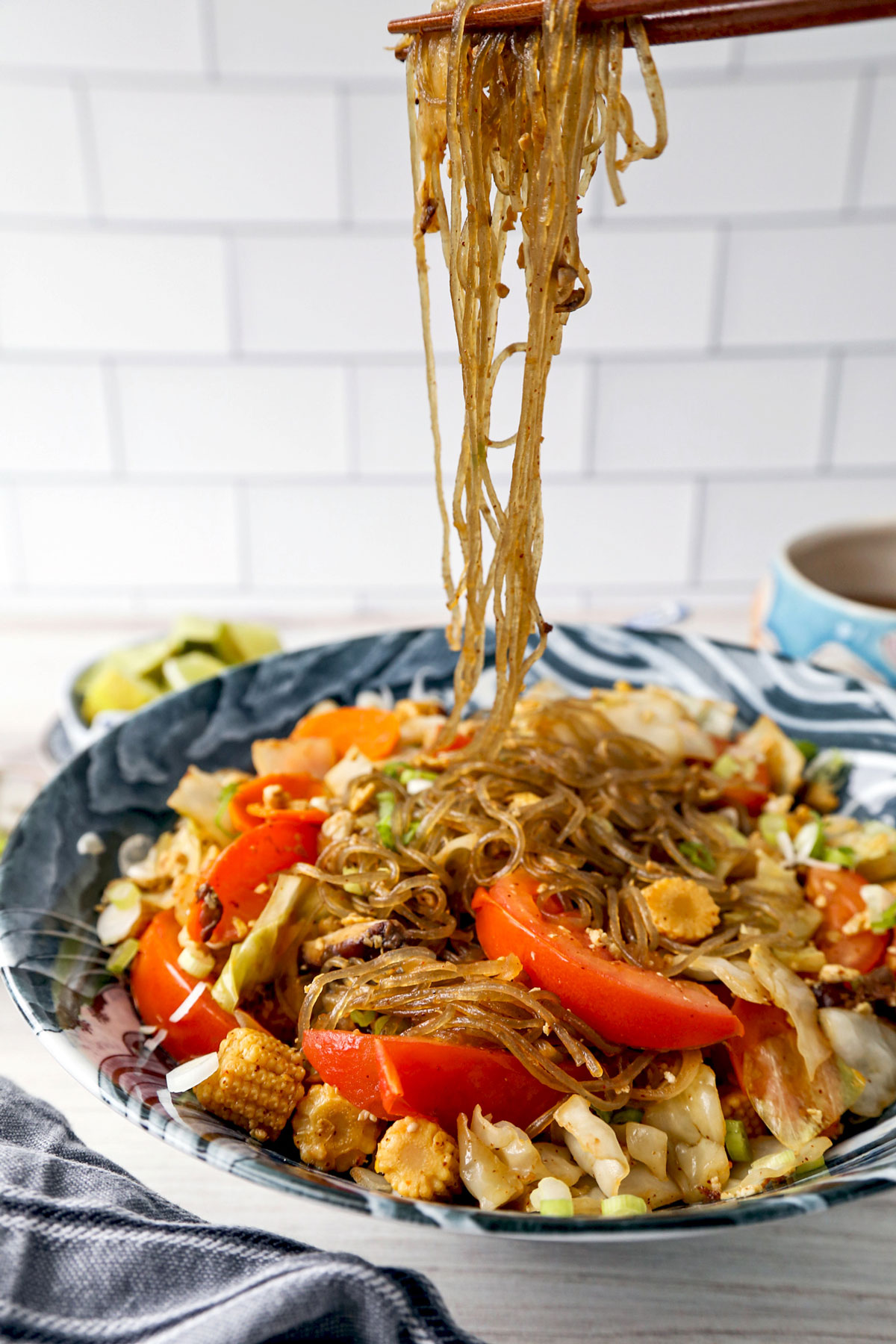
Storage
Fridge: Transfer the noodles to an airtight storage container and refrigerate for up to 5 days.
Reheating: Reheat in the microwave with the lid slightly open for 1 minute. Stir the noodles and microwave for an additional minute.
Can I freeze Pad Woon Sen?
Unfortunately not. I don’t recommend going down that road since these glass noodles won’t stand up well to the freezing cold and may end up being overcooked or mushy.
What to Serve with Pad Woon Sen
This stir fried noodle dish can stand own its own as a full-on meal – or you can serve it alongside other Asian favorites like:
- Chinese Eggplant With Garlic Sauce
- Thai Basil Chicken
- Easy Vegetable Egg Rolls
- Thai Green Curry
- Green Salad With Japanese Carrot Ginger Salad Dressing
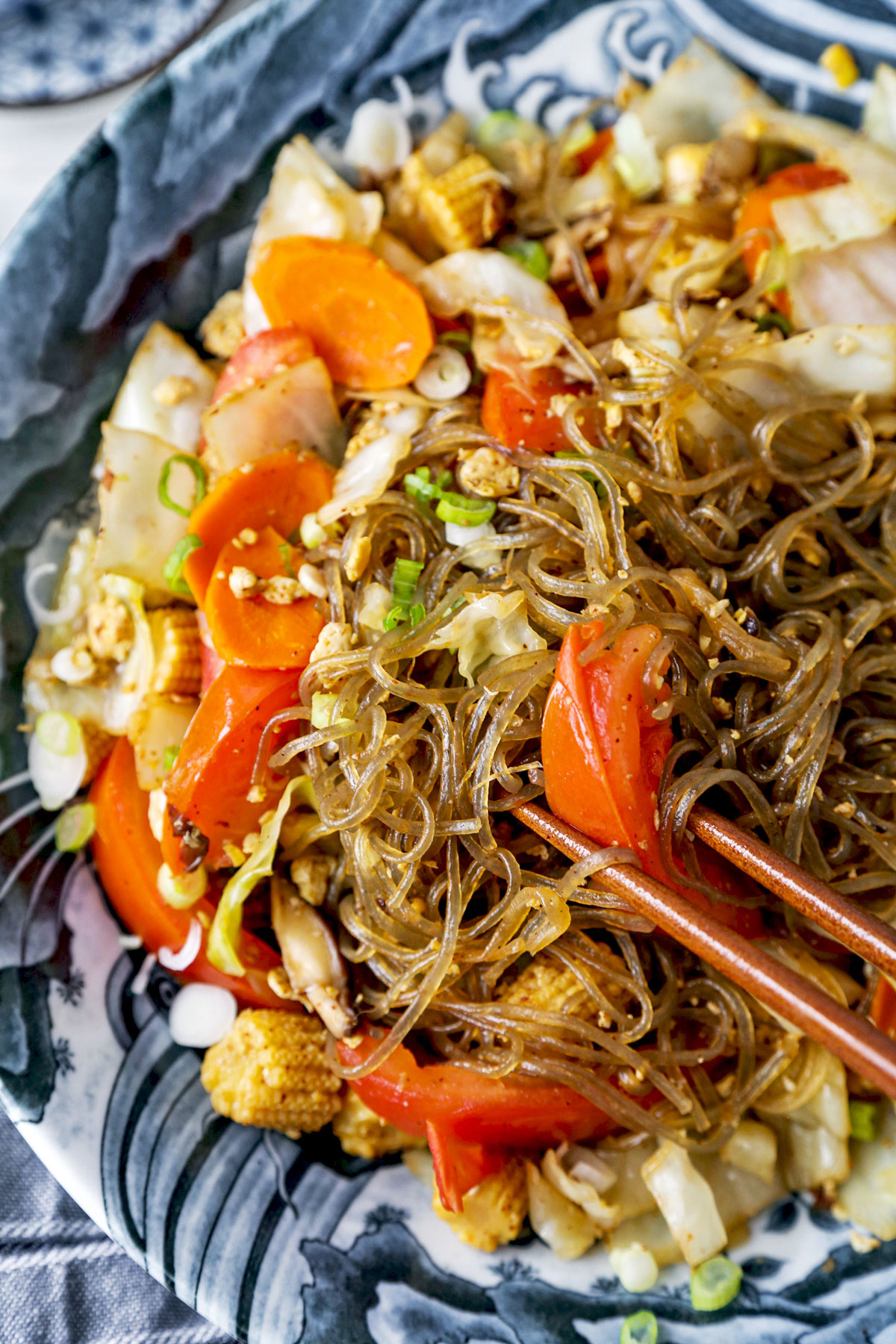
Did you like this pad woon sen recipe? Are there changes you made that you would like to share? Share your tips and recommendations in the comments section below!
Print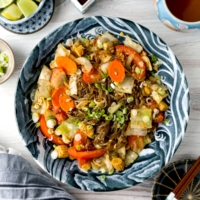
Pad Woon Sen (Thai Glass Noodle Stir Fry)
- Prep Time: 15 minutes
- Cook Time: 6 minutes
- Total Time: 21 minutes
- Yield: 2
- Category: Noodles
- Method: Stir fry
- Cuisine: Thai
- Diet: Vegetarian
Description
Pad woon sen is a delicious and easy to make Thai glass noodle stir fry, packed with colorful veggies and tossed in a sweet and savory sauce.
Ingredients
- 3 ounces glass noodles
- 1 1/2 tablespoon soy sauce
- 1 tablespoon oyster sauce
- 1 tablespoon fish sauce
- 1 teaspoon sugar
- 1/2 teaspoon chili powder
- 2 tablespoons water
- 2 tablespoons vegetable oil or other neutral oil
- 2 large eggs, whisked
- 1/2 small onion, julienned
- 2 garlic cloves, minced
- 1 cup green cabbage, chopped into bite size pieces
- 1/2 cup carrot, sliced on the bias
- 1/2 cup fresh shiitake mushrooms, sliced
- 1/2 cup baby corn, well drained
- 1 tomato, seeds removed and cut into wedges
- 2 scallions, finely chopped
Instructions
- Soak the glass noodles in tepid water for 15 minutes. Drain well and set aside.
- Mix the soy sauce, oyster sauce, fish sauce, sugar, water, and chili powder in a bowl, and set aside.
- Add the vegetable oil to a wok or deep skillet over medium high heat. Add the eggs and scramble them.
- Add the onion, carrot, garlic, cabbage, carrot, and baby corn, and stir fry for 3-4 minutes, until the vegetables have softened but still yield a slight crunch.
- Add the noodles and the sauce and toss well. Keep stir frying until the noodles have absorbed most of the sauce.
- Stir in the tomato and turn the heat off.
- Transfer the dish to a plate and top with scallions. Serve.
Notes
Fridge: Transfer the noodles to an airtight storage container and refrigerate for up to 5 days.
Reheating: Reheat in the microwave with the lid slightly open for 1 minute. Stir the noodles and microwave for an additional minute.
Nutrition
- Serving Size: 1
- Calories: 452
- Sugar: 12g
- Sodium: 1412.6mg
- Fat: 19.9g
- Saturated Fat: 12.9g
- Unsaturated Fat: 1.7g
- Trans Fat: 0g
- Carbohydrates: 54.6g
- Fiber: 6.2g
- Protein: 16.7g
- Cholesterol: 186mg
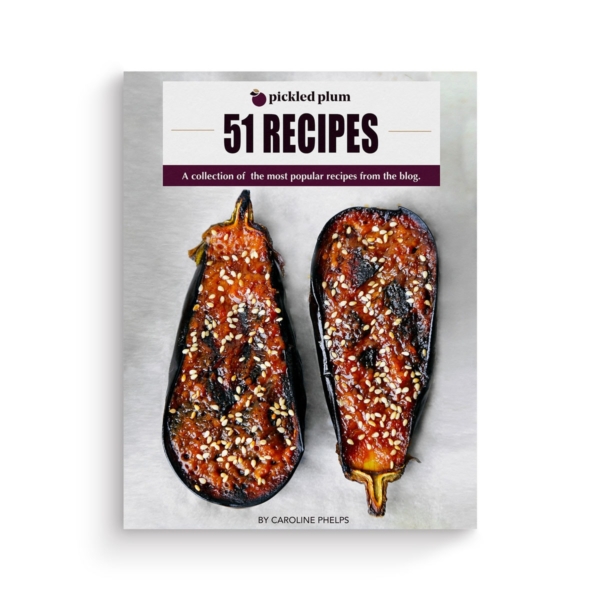
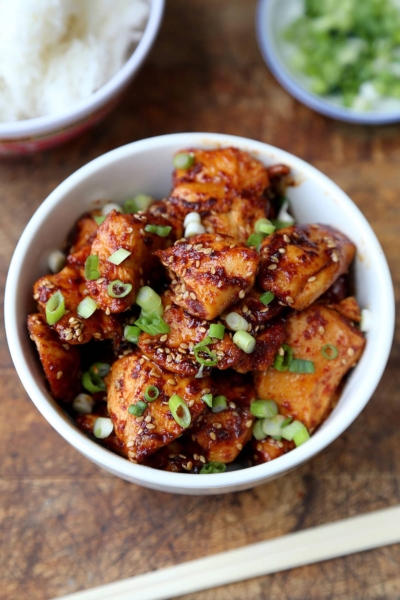
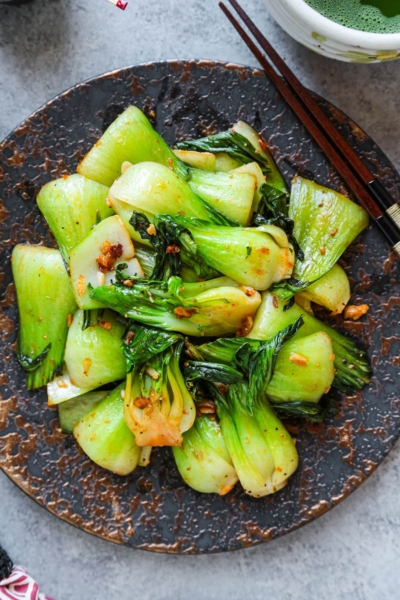
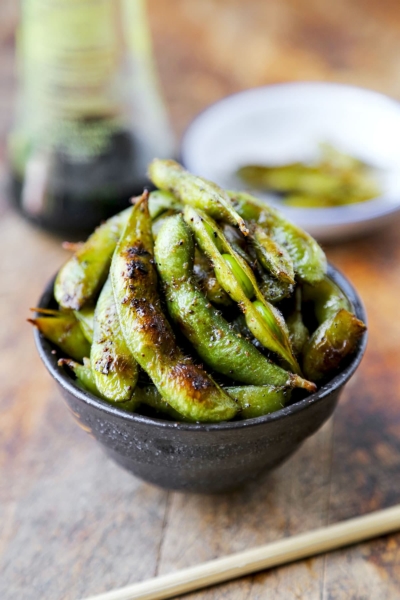
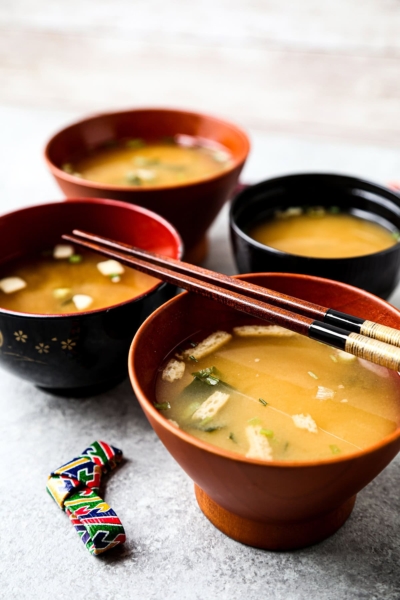
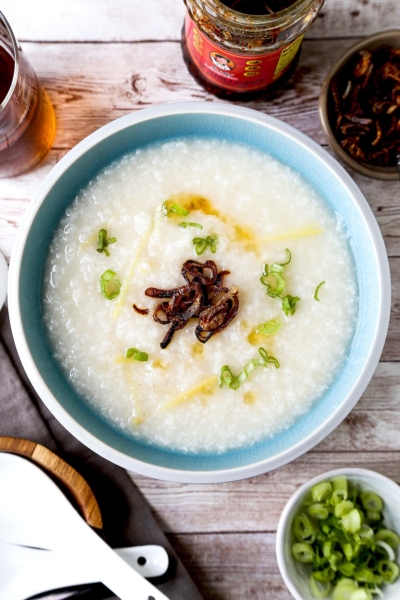









Delicious ! The only thing I didn’t like were the carrots but only because they were not cooked enough, otherwise, I loved it. I didn’t use the baby corn either because I don’t like it. Will make again. Thought it looks just like your photo.
Wonderful Suzanne! Thank you for sharing 🙂
This is the first time I heard about glass noodles, and they are already my favorites. I have made your recipe thrice now and more is coming. I absolutely love it!
This was delicious! I changed the veggies a little to suit what we had on hand, and halved the fish sauce (to suit my husband). Exceeded my expectations.